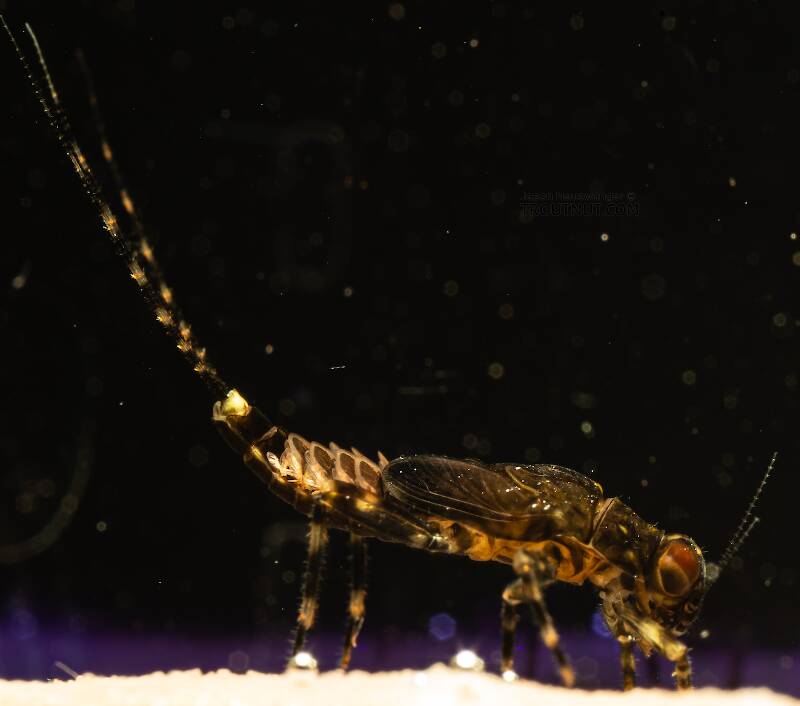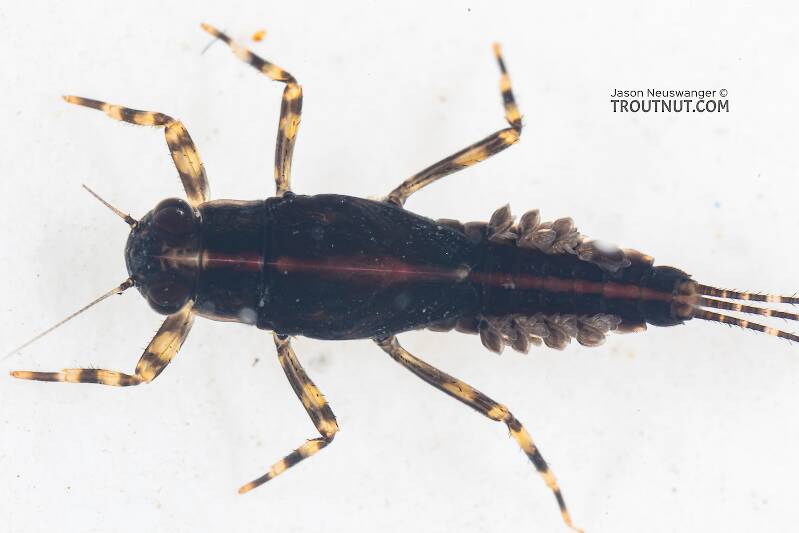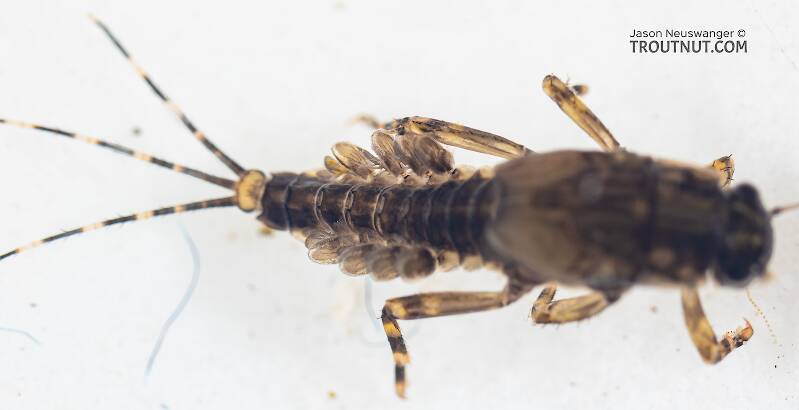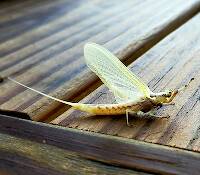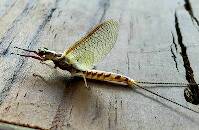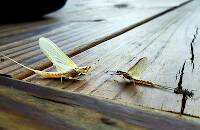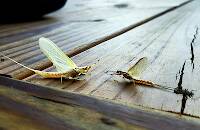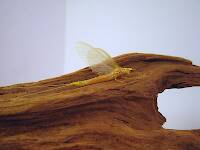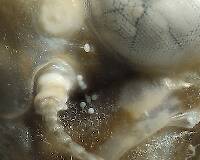
Salmonflies
Pteronarcys californica
The giant Salmonflies of the Western mountains are legendary for their proclivity to elicit consistent dry-fly action and ferocious strikes.
Featured on the forum

Troutnut is a project started in 2003 by salmonid ecologist Jason "Troutnut" Neuswanger to help anglers and
fly tyers unabashedly embrace the entomological side of the sport. Learn more about Troutnut or
support the project for an enhanced experience here.
This topic is about the Mayfly Genus Serratella
Prior to recent revisions, this genus of elegant little dark mayflies with their small dark bodies, dark slate wings, and paler legs and tails was more important to anglers. What was the East's most significant species is now known as Teloganopsis deficiens (Little Black Quill). The only remaining species reported of value to the eastern angler is Serratella serrata (Little Sooty Olive).These changes have had an even bigger impact in the West. The significant Summer hatching tibialis has been moved back to its old genus and is again called Ephemerella tibialis (Small Western Dark Hendrickson). The next most prominent species (though of only minor importance) is now called Matriella teresa and is the only recognized species of that genus in North America. The very minor species velmae has also been moved, and is now back in Ephemerella. This leaves only a few western species in this genus, and they are of no reported significance to anglers.
Example specimens
ZenCane on Apr 3, 2010April 3rd, 2010, 5:58 am EDT
In "Splitting Cane", Ed Engle refers to the "elusive flightless Serratella mayfly" - does anyone know if this was a joke, or if there is such a thing? "Mayflies" by Knopp & Cormier certinaly does not mention such a beast.
Thanks
Thanks
GONZO on Apr 3, 2010April 3rd, 2010, 7:09 am EDT
Marvin,
In a 2008 paper on Eurylophella oviruptis (a parthenogenetic mayfly that oviposits by abdominal bursting), David Funk mentions that George Edmunds and Mike Lawson found an (apparently) parthenogenetic Serratella species on the Frying Pan that also appeared to reproduce by abdominal bursting. I believe this is the "flightless" Serratella in question.
In a 2008 paper on Eurylophella oviruptis (a parthenogenetic mayfly that oviposits by abdominal bursting), David Funk mentions that George Edmunds and Mike Lawson found an (apparently) parthenogenetic Serratella species on the Frying Pan that also appeared to reproduce by abdominal bursting. I believe this is the "flightless" Serratella in question.
Jmd123 on Apr 3, 2010April 3rd, 2010, 1:19 pm EDT
"Abdominal bursting" - now that sounds like a rather unpleasant way to reproduce. Though, probably no worse than being gobbled by a trout while you are trying to squeeze out an eggsack...
Jonathon
Jonathon
No matter how big the one you just caught is, there's always a bigger one out there somewhere...
Oldredbarn on Apr 5, 2010April 5th, 2010, 4:03 am EDT
Gonzo,
You just can't leave this here...Give us some more info...Are you pulling our legs here??? "oviruptis" Come on!? I'm not too sure you are not grinning ear to ear at this point. This smells a little like my post a while back, that everyone ignored, about the mayfly that I saw in a program on TV about caves that I named E caverna...
You and I both know that "mother nature" on her worst day can freak us out with her weirdness, but abdominal bursting...Wow! Where's the fun in that?! There's probably not a male alive that hasn't undergone a little penile shrinkage after viewing, for the first time, a female mantis devouring her male mate after copulation...But this...Sorry...But I need a moment...He, he!
Spence
You just can't leave this here...Give us some more info...Are you pulling our legs here??? "oviruptis" Come on!? I'm not too sure you are not grinning ear to ear at this point. This smells a little like my post a while back, that everyone ignored, about the mayfly that I saw in a program on TV about caves that I named E caverna...
You and I both know that "mother nature" on her worst day can freak us out with her weirdness, but abdominal bursting...Wow! Where's the fun in that?! There's probably not a male alive that hasn't undergone a little penile shrinkage after viewing, for the first time, a female mantis devouring her male mate after copulation...But this...Sorry...But I need a moment...He, he!
Spence
"Even when my best efforts fail it's a satisfying challenge, and that, after all, is the essence of fly fishing." -Chauncy Lively
"Envy not the man who lives beside the river, but the man the river flows through." Joseph T Heywood
"Envy not the man who lives beside the river, but the man the river flows through." Joseph T Heywood
Troutnut on Apr 5, 2010April 5th, 2010, 4:48 am EDT
Here's the abstract of the scientific article in the well-respected Journal of the North American Benthological Society:
Very cool!
A new parthenogenetic mayfly (Ephemeroptera:Ephemerellidae:Eurylophella Tiensuu) oviposits by abdominal bursting in the subimago
David H. Funk, John K. Jackson, Bernard W. Sweeney
Eurylophella oviruptis new species is described and illustrated from female larvae and reared subimagos and imagos collected from swamp streams in North Carolina, USA. Several key morphological characters in the larva place this new species in the Eurylophella temporalis group. Genetic comparisons with other eastern North American Eurylophella revealed a fixation of alleles unique to E. oviruptis at 4 of 19 allozyme loci. Eurylophella oviruptis appears to be obligately parthenogenetic because no males were observed in the field or laboratory and eggs taken from subimagos and imagos hatched parthenogenetically (mean hatch rate = 79%). Abdomens of 60% of subimagos reared in the laboratory burst along the ecdysial line of the first 3 tergites immediately after transformation to the subimago at the water surface. Abdominal bursting ruptured the oviducts, released most of the eggs into the water, and left the subimago trapped on the water surface with a large, inflated midgut protruding from the split in the tergites. Subimagos that did not burst (40%) flew from the water surface, molted to the imago on the 2nd day following emergence, and then, without having mated, extruded a ball of eggs that was released into the water. Dissections of E. oviruptis and 5 other species of mayflies showed that inflation of the mayfly gut normally occurs at 3 stages: emerging larvae inflate prior to and during the molt to the subimago, subimagos (particularly males) inflate further at the imaginal molt, and female imagos inflate even further at oviposition. Gastrointestinal inflation in mayflies maintains full abdominal distention that might facilitate flight. Abdominal bursting in E. oviruptis subimagos appears to be the result of gut inflation well beyond the amount normally associated with this stage. The evolutionary significance (predation, dispersal, demographics) of oviposition by abdominal bursting is discussed.
Very cool!
Jason Neuswanger, Ph.D.
Troutnut and salmonid ecologist
Troutnut and salmonid ecologist
GONZO on Apr 5, 2010April 5th, 2010, 5:16 am EDT
Spence,
I think we (male Homo sapiens) can be extremely grateful that a number of the reproductive strategies found in other species have yet to evolve in our own. If the notion of "gut-busting" female mayflies and cannibalistic female mantids causes some penile shrinkage, consider the example of mating in the ceratioid anglerfishes. The puny male parasitizes the larger female, becoming assimilated into her body. As tempting as the notion of living off your mate for the rest of your life might seem at first blush, the males eventually atrophy into little more than gonads. What's worse, perhaps, is that she gets to do all the fishing.
I think we (male Homo sapiens) can be extremely grateful that a number of the reproductive strategies found in other species have yet to evolve in our own. If the notion of "gut-busting" female mayflies and cannibalistic female mantids causes some penile shrinkage, consider the example of mating in the ceratioid anglerfishes. The puny male parasitizes the larger female, becoming assimilated into her body. As tempting as the notion of living off your mate for the rest of your life might seem at first blush, the males eventually atrophy into little more than gonads. What's worse, perhaps, is that she gets to do all the fishing.
Oldredbarn on Apr 5, 2010April 5th, 2010, 5:26 am EDT
Well Jason & Gonzo this is going to take a few moments at the vise! Hmmmm...
Spence
PS I went to lunch and thought about this some more. I know that somewhere in all that scientific-ease there is probably an explanation, but when are these eggs fertilized? If the female is shedding these at the water surface as she's emerging...(?) We need some translating here.
Spence
PS I went to lunch and thought about this some more. I know that somewhere in all that scientific-ease there is probably an explanation, but when are these eggs fertilized? If the female is shedding these at the water surface as she's emerging...(?) We need some translating here.
"Even when my best efforts fail it's a satisfying challenge, and that, after all, is the essence of fly fishing." -Chauncy Lively
"Envy not the man who lives beside the river, but the man the river flows through." Joseph T Heywood
"Envy not the man who lives beside the river, but the man the river flows through." Joseph T Heywood
GONZO on Apr 5, 2010April 5th, 2010, 6:08 am EDT
...when are these eggs fertilized?
They are not fertilized. An explanation of parthenogenesis here: http://en.wikipedia.org/wiki/Parthenogenesis
Gutcutter on Apr 5, 2010April 5th, 2010, 4:07 pm EDT
so troutnutters--
the next time the little lady tells you that she is feeling bloated - head for the hills!! don't let her explode all of those tiny babies all over you.
or show her this thread and tell her you're scared of her and have to go fishing for a few days...
beware the dreaded oviruptus
the next time the little lady tells you that she is feeling bloated - head for the hills!! don't let her explode all of those tiny babies all over you.
or show her this thread and tell her you're scared of her and have to go fishing for a few days...
beware the dreaded oviruptus
All men who fish may in turn be divided into two parts: those who fish for trout and those who don't. Trout fishermen are a race apart: they are a dedicated crew- indolent, improvident, and quietly mad.
-Robert Traver, Trout Madness
-Robert Traver, Trout Madness
Quick Reply
Related Discussions
Topic
Replies
Last Reply
8
Jan 7, 2009
by Dgracia
by Dgracia
8
Jun 5, 2007
by Dinerobyn
by Dinerobyn
4
May 24, 2008
by Softhackle
by Softhackle



